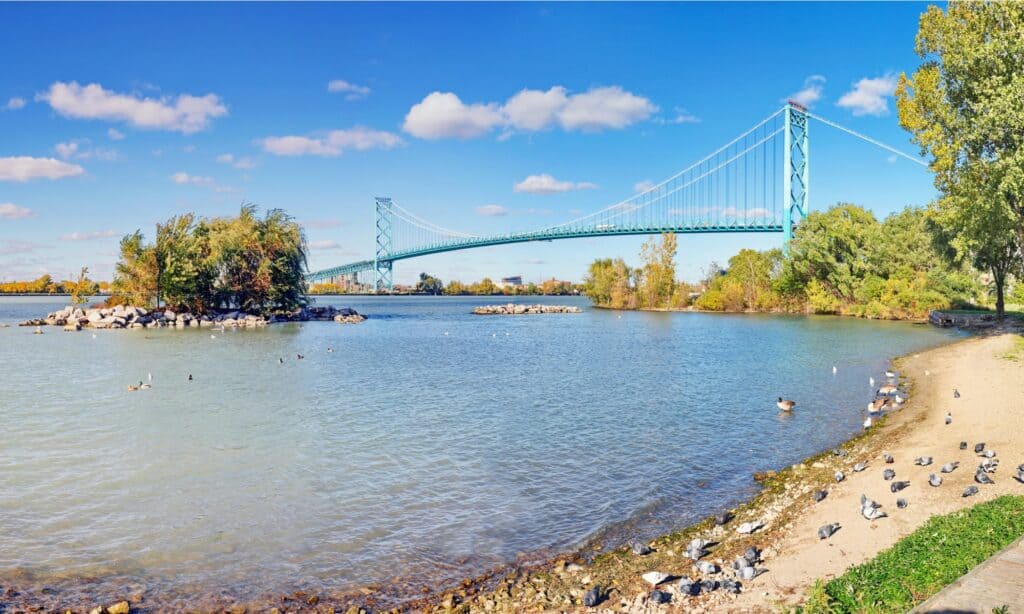The Detroit River is a waterway that plays a huge role in the surrounding culture. It serves as an important natural and cultural asset to the region, flowing through the heart of North America. This river spans about 32 miles in total, forming a border between the United States and Canada.
It also connects Lake St. Clair to Lake Erie, making it a vital shipping route for commercial vessels. This river has played a pivotal role in the growth and development of Detroit.
Besides all the economic opportunities this river brings, it also provides the option for many recreational activities, including boating, fishing, and swimming. However, there is some question about whether this water is really safe or not.
The Detroit River Ecosystem

The river is home to several aquatic species, including fish and mussels.
©iStock.com/Simplyphotos
The Detroit River is pretty important, as we’ve stated above. It holds immense geographical and cultural significance. However, it also plays a vital role in the ecology of the Great Lakes system. It funnels water, nutrients, and life between the lakes, and the water flow helps sustain both lakes.
This river is home to diverse aquatic species, including fish, mussels, and invertebrates. Some species, like the lake sturgeon, are considered endangered. Luckily, many of these animals are completely harmless to people and don’t make the water dangerous to swim in.
However, it’s crucial to realize that wildlife is always there, and there is always a risk when swimming around them. It’s best to give all wildlife plenty of room to avoid harmful interactions.
This river is also a stopover for migratory birds as they make their way from the northern breeding grounds to the southern wintering habitats. The extensive wetlands and islands in the river provide essential resting and feeding areas for these birds. However, the vast majority of these birds are completely harmless to humans.
However, you should be careful not to disturb these birds while swimming. The chance to rest while migrating is absolutely required for their survival.
The Detroit River is also an essential habitat for many plant species. These plants act as buffers, filtering pollutants and providing habitat for wildlife. Therefore, they’re essential for the ecosystem, too. While these plants aren’t dangerous, you shouldn’t disturb them whenever possible.
Pollution Concerns

The Detroit River is very urbanized in some areas, which may make it unsafe to swim in.
©Belikova Oksana/Shutterstock.com
While wildlife isn’t dangerous in the Detroit River, you should be cautious about pollution. This river has dealt with a pollution problem for a long time. This pollution can be a danger for both humans and wildlife.
This pollution comes from several sources. The most significant is the industrial activities in the area. Manufacturing, petrochemical processes, and shipping all lead to pollution in the river. These industries discharge pollutants directly into the river, and they can also lead to contamination over time.
Chemical pollutants and heavy metals are also a concern, as they come from many industrial activities in the area.
Urbanization around the Detroit River is also a concern, as urban runoff also pollutes water. Stormwater runoff from roads and parking lots can contain oil, heavy metals, and chemicals.
In the past few decades, the state has tried to clean up the Detroit River. Several cleanup initiatives have been launched to reduce industrial pollution and restore contaminated areas. Shoreline restoration and habitat enhancement have helped several wildlife species.
Regulations have been passed to reduce the chance of further pollution, as well. These regulations set standards for water quality and establish guidelines for pollutant discharges.
Is The Detriot River Safe to Swim In?

Although the water may look “fine,” take precautions before jumping in the river.
©Lu Yang/Shutterstock.com
The safety of swimming in the Detroit River can vary somewhat from time to time and place to place. The most critical factor is water quality, which changes constantly. You should regularly check the water quality in your area for bacterial contamination, toxic substances, and other pollutants. High levels of contaminants can pose a risk to swimmers.
The Detroit River also has currents and tides that need to be considered. These can make swimming challenging or even dangerous in some rare cases. Inexperienced swimmers are at the most risk. It’s important to always swim cautiously and remember that the Detroit River is a natural area.
Weather can change rapidly in the Great Lakes region, as well. This may affect water conditions, making it more or less dangerous to swim. Strong winds and storms can impact swimming safety.
Be sure to swim only in designated areas in the Detroit River. These aren’t in all areas. However, if they are in your area, you should absolutely use them. Often, these areas are more closely monitored and may have extra safety measures put in place.
When swimming, be aware of currents and tides in your area. Avoid swimming near shipping lanes and other areas with strong currents. Wear safety devices whenever possible, and be very careful with small children and inexperienced swimmers.
Always check the weather conditions before you go. If a storm is approaching or winds are high, it’s best to postpone swimming.
What About Potential Health Risks?
There are some health risks that are always around when swimming in a natural body of water, and the Detroit River is no different. For instance, water always poses a risk of waterborne diseases. Ingesting or coming into contact with bacteria, viruses, and parasites in the water can lead to all sorts of health problems.
There is no way to eliminate this risk completely. If you’re in a natural body of water, these health problems are always a risk.
You can also come into contact with pollutants like chemicals and heavy metals. When absorbed through the skin or accidentally ingested, these may have an adverse health effect.
While efforts have been made to improve the water quality of the Detroit River, it is essential to exercise caution and follow safety guidelines to minimize health risks when swimming.
Swimming Restrictions in the Detroit River?

The Detroit River includes the 985-acre park Belle Isle, and in the past, it’s been a popular area for swimming.
©Nicholas Worden/Shutterstock.com
There may be some areas of the Detroit River where you cannot swim. Local authorities may decide that some areas are too unsafe for swimmers, or they may be important places for fish or other wildlife. It’s important to always check for restrictions in your area.
Belle Isle, an island park in the Detroit River, is a popular swimming beach and regularly sees visitors hitting the water. As we’ve stated, try to swim in designated areas when possible. Follow guidelines for when swimming is allowed in these areas at all times, too. Sometimes, swimming may be temporarily prohibited due to safety concerns.
The photo featured at the top of this post is © iStock.com/Simplyphotos
Thank you for reading! Have some feedback for us? Contact the AZ Animals editorial team.






